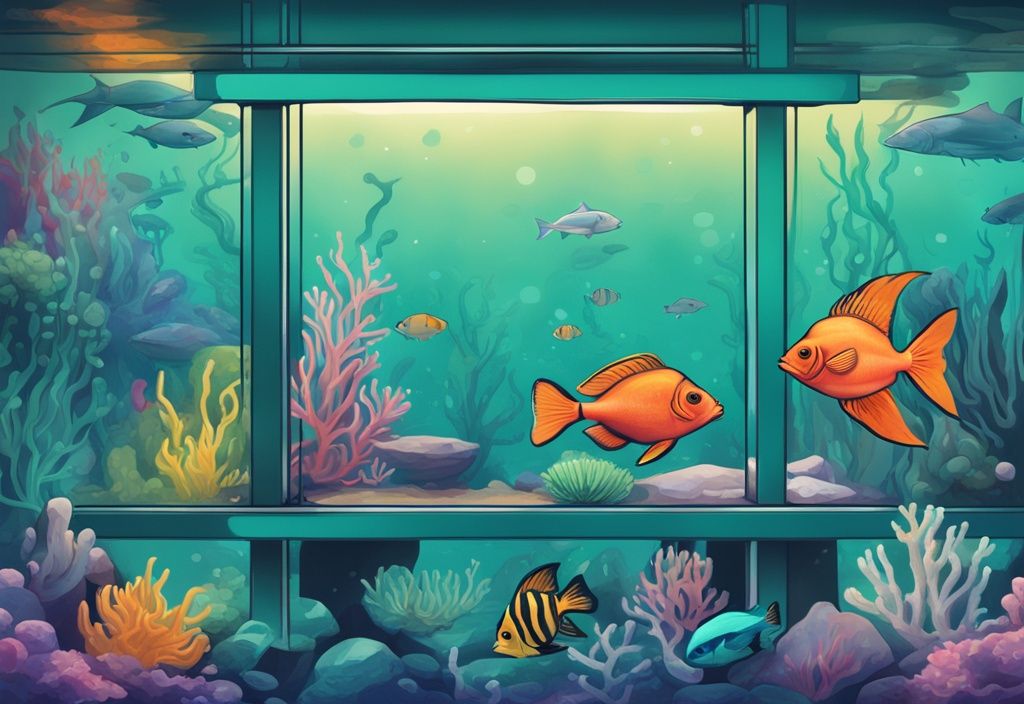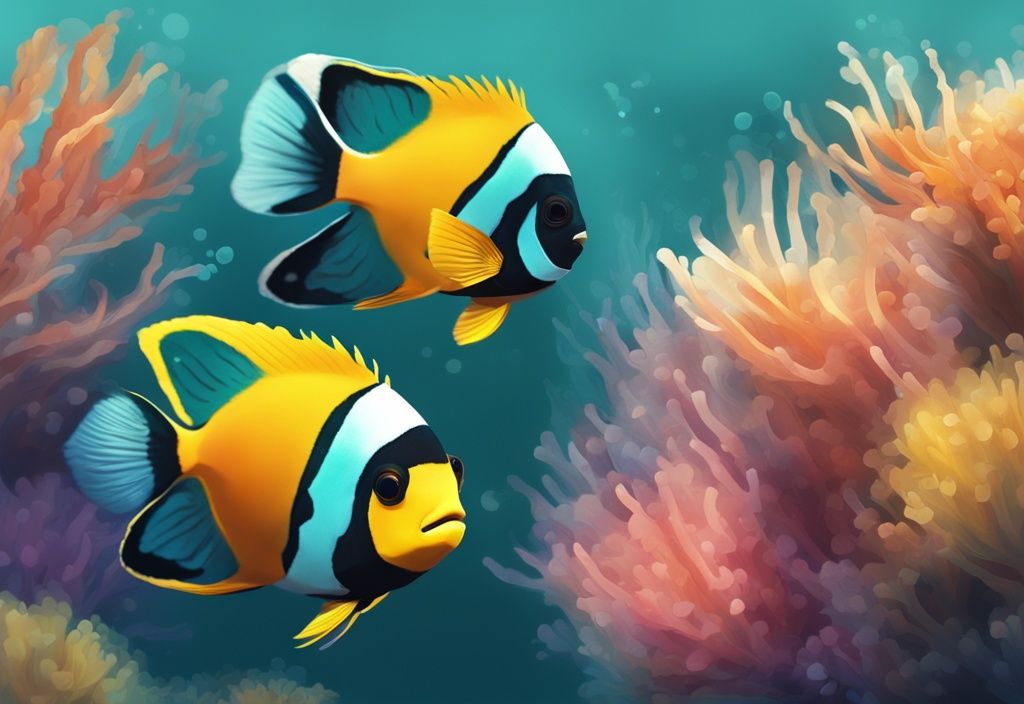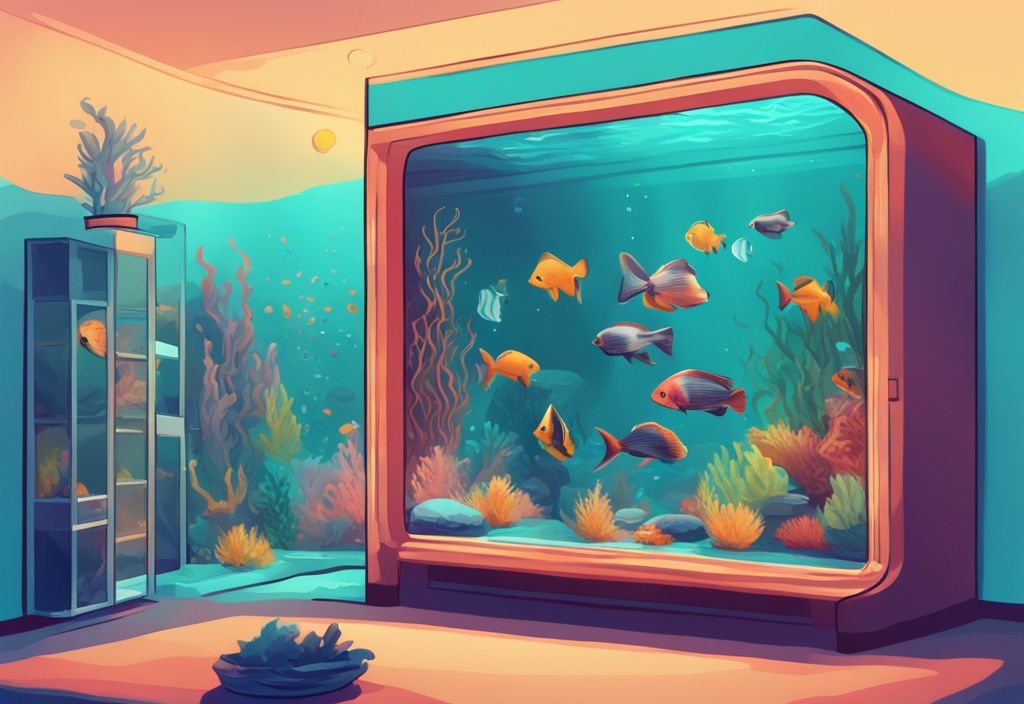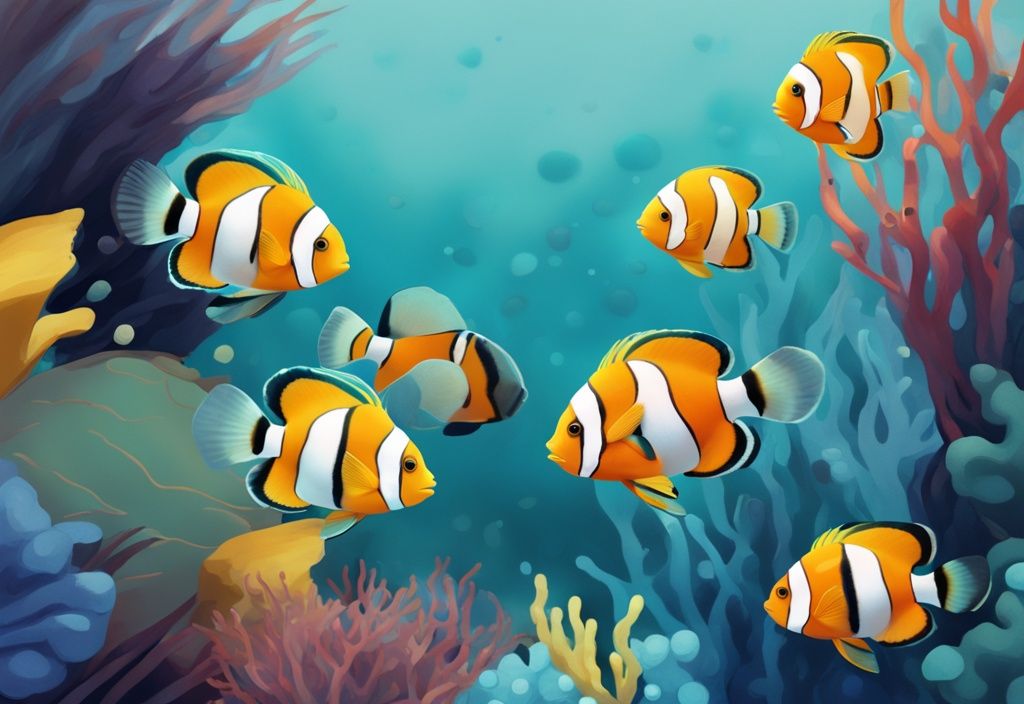Dive into the fascinating world of marine life with your very own saltwater aquarium! But where to begin? Steering your curiosity into actionable steps can be daunting, especially for beginners. In this guide, we turn the tide by demystifying starting a saltwater aquarium fish for beginners.
Unravel the mysteries of marine water chemistry, fish selection, and habitat arrangement in a way you never imagined. With over two decades of experience as a marine biologist, I’ve made it my mission to show you, in clear, easy-to-understand terms, how straightforward it can be to set up your first mesmerizing marine tank.
Remember, setting up a thriving saltwater aquarium doesn’t have to resemble rocket science. Guided by expertise and hearty passion, and with a dash of patience, you’re soon to discover the joy of watching your own marine world flourish. Welcome to the captivating journey into aquaristics!
Beginners Introduction to Saltwater Aquarium Fish
Starting out with saltwater aquarium fish for beginners is akin to embarking on an aquatic adventure. The vibrancy and diversity of marine life offer a mesmerizing spectacle, but it does come with its set of challenges. Unlike freshwater tanks, saltwater aquariums are intricate systems that demand both specific equipment and regular upkeep to flourish.
A cornerstone of this hobby for beginners is mastering the nuances of water chemistry. Paramount parameters like pH, salinity, and nitrate levels require diligent monitoring to maintain a thriving environment. Think of it as cooking a complex dish; each ingredient must be measured precisely, as imbalances can result in stressed or sick fish.
Choosing the right saltwater aquarium fish for beginners is essential, akin to picking sturdy plants for an amateur gardener. Opt for species known for their hardiness and adaptability, which can tolerate minor fluctuations in water conditions. Hardy fish like the charming Clownfish or the sturdy Clown Goby are not only affordable but forgiving of novice mistakes, making them excellent choices.
By integrating proper care strategies and making thoughtful fish selections, the journey becomes considerably smoother. Starting with resilient species allows beginners to build confidence and skills, eventually creating a harmonious and stunning saltwater ecosystem. This step-by-step approach is not just about maintaining an aquarium; it’s about cultivating a rewarding lifelong hobby in marine fishkeeping.
Selecting Your First Saltwater Fish: A Guide for Beginners
Embarking on the journey of curating a saltwater aquarium is a thrilling endeavor. This section will delve into the considerations and recommendations essential for selecting beginner-friendly fish, ensuring a harmonious and thriving aquatic ecosystem.
Factors to Consider: Choosing Beginner-Friendly Fish
Choosing the right saltwater aquarium fish for beginners requires careful consideration. Start by selecting species that can endure minor fluctuations in water conditions and common beginner mistakes. Fish that are hardy are perfect candidates, as they are more resilient to changes.
Inexpensive fish that do not require large tanks can help minimize initial investment and upkeep costs. This is crucial as you gain experience managing a saltwater aquarium. For those who are also interested in enhancing their aquarium with plants, learning how to plant aquarium plants can be a valuable skill. Additionally, consider the compatibility of the fish you choose. Ensuring species can cohabit peacefully will prevent aggression and reduce stress within the tank.
Introducing fish gradually is another important step. Begin with the least aggressive species. Slowly add other fish over time, allowing each one to acclimate and avoid territorial disputes. This methodical approach can help create a harmonious environment from the outset.
Top Recommendations for Beginner Saltwater Fish
For those new to saltwater aquariums, several species stand out as particularly suitable choices:
- Clownfish: Known for their hardiness and ease of care, Clownfish need a minimum tank size of 20 gallons. These omnivores are peaceful and adapt well to various conditions.
- Damselfish: These fish are very hardy and can tolerate a range of water conditions. They need a tank size of at least 30 gallons and, while semi-aggressive, they can thrive well in a community tank if managed properly.
- Green Chromis: Inexpensive and resilient, Green Chromis are omnivorous and require a minimum tank size of 30 gallons. They are peaceful and active swimmers, making them great for beginners.
- Cardinalfish: Cardinalfish are hardy carnivores that require a tank size of at least 30 gallons. They are generally peaceful to semi-aggressive, fitting well in a community setup with appropriate tank mates.
- Clown Goby: These small, carnivorous fish are inexpensive and hardy, requiring a minimum tank size of just 10 gallons. Their peaceful nature makes them ideal companions for many other species.
- Royal Gramma: Royal Grammas are colorful, hardy fish that need a tank of at least 30 gallons. Carnivorous and peaceful, they are a great addition to any beginner’s aquarium.
- Coral Beauty Angelfish: These fish are both hardy and colorful, requiring a minimum tank size of 70 gallons. As omnivores with semi-aggressive tendencies, they add visual appeal and dynamic behavior to the aquarium.

A Step by Step Guide to Your First Saltwater Aquarium Setup
Setting up your very first saltwater aquarium can be an exciting yet daunting task. With the right approach and essential equipment, you can create a thriving, vibrant aquatic environment.
Essential Equipment for Your Saltwater Aquarium
When diving into the world of saltwater aquariums, selecting the proper equipment is crucial. Here are the key items you’ll need:
- Tank: For beginners, it’s advisable to start with a tank size of at least 20 gallons. Larger tanks provide a more stable environment, which is beneficial for maintaining consistent water conditions.
- Filtration system: A comprehensive filtration system is vital due to the higher waste production in saltwater tanks. Ensure your system includes mechanical, chemical, and biological filtration to keep the water pristine.
- Heater: Stability is key for saltwater aquarium fish for beginners. A reliable heater maintaining temperatures between 76-78°F is essential to prevent stress caused by temperature fluctuations.
- Lighting: Proper lighting is not just for aesthetics but is crucial if you plan to keep corals. Opt for lighting that simulates natural sunlight, promoting coral health and growth.
- Powerheads: These devices ensure appropriate water flow and oxygenation within the tank. Good water movement distributes nutrients evenly, maintaining optimal water conditions.
- Testing kits: Regular monitoring of water parameters is critical. High-quality testing kits allow you to check pH, salinity, nitrates, and nitrites, ensuring your tank remains a healthy habitat.
Preparation and Best Practices for Saltwater Fish Maintenance
Maintaining a thriving saltwater aquarium involves consistent care and attention. Here are some fundamental practices for keeping your fish healthy and your aquarium balanced:
- Cycle the tank: Before introducing any fish, it’s essential to complete the nitrogen cycle. This process cultivates beneficial bacteria that convert harmful ammonia and nitrite into less toxic nitrate, creating a safe environment.
- Use live rock: Incorporate live rock into your aquarium. Not only does it offer natural filtration, but it also provides shelter for your fish and hosts beneficial bacteria that bolster biological filtration.
- Start with the least aggressive fish: When stocking your tank, begin with less aggressive species. This strategy helps minimize stress and territorial disputes, allowing new fish to acclimate comfortably.
- Follow acclimation methods: Proper acclimation is critical to the health of your saltwater aquarium fish for beginners. Techniques like drip acclimation or the floating bag method help fish adjust to new water chemistry and temperature smoothly.
Nutrition Basics: Feeding Your Saltwater Fish
Feeding your saltwater aquarium fish for beginners involves understanding their dietary needs and learning the best strategies for feeding. Here’s a comprehensive guide to ensure your fish are happy and healthy.
Understanding Your Fish’s Dietary Needs and Types of Food
When diving into the world of saltwater aquariums, one quickly realizes that each species comes with its own set of dietary requirements. It’s like hosting a party where everyone’s favorite dishes need to be on the table. Thorough research before picking your fish is crucial to ensure you’re catering to their nutritional needs from the get-go.
A balanced diet is fundamental. Imagine if you only ate bread—no doubt you’d be craving something more. Your fish are no different! Offering a variety of live, frozen, and dry foods is akin to preparing a three-course meal.
Live foods like brine shrimp or bloodworms are the equivalent of a gourmet starter, while high-quality frozen foods serve as a convenient yet nutritious main course. Dry foods, enriched with essential vitamins and minerals, should be the staple dessert your fish always count on.
Herbivores thrive on algae-based foods, reminiscent of their natural oceanic grazing habits. If you notice unusual behavior in your fish, such as your betta fish staying at the bottom of the tank, it may indicate an issue with their diet or habitat.
Carnivores, however, have an appetite for meaty, protein-rich foods. Recognizing these dietary distinctions allows you to create a balanced culinary experience for your aquarium’s inhabitants.
Tips and Tricks: How to Feed Your Fish
Feeding your saltwater aquarium fish for beginners requires a thoughtful approach. Start by feeding them small amounts twice a day. This method prevents overfeeding—a common pitfall that can degrade water quality and jeopardize your fish’s health. It also ensures every fish gets its fair share, promoting harmony within the tank.
Another pro tip: promptly remove uneaten food after feeding. This habit prevents decaying food from elevating harmful ammonia and nitrate levels in your tank, which could otherwise harm your fish. Regularly tidying up post-meal helps maintain a pristine and balanced aquarium environment.
Establishing a consistent feeding schedule benefits both you and your fish. They learn to anticipate feeding times, reducing stress and making your maintenance routine straightforward. With these strategies, you’ll find that feeding your saltwater aquarium fish is not only manageable but actually quite rewarding.
Maintaining A Healthy Aquarium Environment
Creating a thriving habitat for your saltwater aquarium fish for beginners demands careful planning and thoughtful attention to detail.

How to Keep Harmony Amongst Your Fish
Maintaining harmony among your saltwater aquarium fish for beginners requires careful observation and planning. Start by keeping a close eye on fish interactions to immediately identify and address any bullying or stress dynamics within the tank. Behavioral issues can quickly escalate, so timely intervention is key.
Equally important is providing plenty of hiding spots using live rocks and corals. These not only enhance the aesthetic appeal of your aquarium but also serve as vital refuges for fish, reducing territorial disputes and offering sanctuaries from aggression.
When selecting fish, prioritize species with compatible temperaments to avoid conflict. Pairing compatible fish, while avoiding overcrowding, helps in creating a peaceful environment. Overcrowding can cause stress and aggression, disrupting the tank’s balance. Ensuring sufficient space for each fish can go a long way in fostering a harmonious aquarium.
Handling and Preventing Common Behavioral Problems
Addressing behavioral issues promptly is essential for maintaining a balanced saltwater aquarium for beginners. If a fish becomes overly aggressive, isolating it temporarily can help reduce tension and allow for improved tank dynamics.
Observation is critical; keep an eye out for signs of stress such as hiding, reduced appetite, or erratic swimming. Early detection can prevent more severe problems down the line.
Proper feeding and water quality play significant roles in preventing behavioral issues. Overfeeding and poor water conditions can lead to stress and health problems, exacerbating aggressive behaviors among fish.
Ensure a balanced diet and maintain optimal water quality to promote a healthy environment. Regular water changes and quality checks can prevent many common issues, fostering a stable and peaceful aquarium setting.
Overcoming Common Problems: A Beginners Guide
Maintaining a saltwater aquarium can be a rewarding experience, but it’s not without its challenges. This guide addresses some of the most common problems faced by those new to the hobby and provides expert advice on how to overcome them.
Algae Outbreak: Causes and Solutions
One of the most frequent issues encountered in saltwater aquarium fish for beginners is an algae outbreak. Algae feed on excessive nutrients, often introduced through overfeeding. Improper lighting schedules and insufficient water changes further exacerbate this problem, creating an optimal environment for algae growth.
To tackle this challenge, establish a regimented schedule for water changes. The mantra here is “less is more” when it comes to feeding. Reducing the amount of food during feedings can significantly curtail nutrient levels. Proper lighting, simulating a natural day/night cycle, plays a pivotal role as well.
Consider integrating algae-eating clean-up crew members like Turbo Snails or Lawnmower Blennies into your aquarium. These little helpers are incredibly efficient at keeping algae under control, preventing future outbreaks and promoting a balanced ecosystem.
Common Fish Diseases and How to Prevent Them
Disease management is crucial when caring for saltwater aquarium fish for beginners. Let’s delve into some common ailments and how to prevent them. Take Ich, for example. Proper acclimation of new fish, quarantining them before they join their tank mates, and maintaining stable water conditions are essential preventive measures.
For Fin Rot, ensure the aquarium water is clean and provide a nutritious diet. Avoid overcrowding the tank, as stress can make fish more susceptible to this condition. When dealing with Marine Velvet, the first step is to isolate the infected fish. Follow this with treating them using copper-based medications to eradicate the parasite.
Regular monitoring and proactive care are the cornerstones of a healthy aquarium. The key is to stay vigilant and address issues promptly to maintain a thriving aquatic environment.
Committing to Your Saltwater Aquarium: Long-term Care
Embarking on the journey of maintaining a saltwater aquarium is a rewarding but sustained commitment. This section will delve into the key aspects of ensuring your marine ecosystem thrives over time.
Ongoing Costs and Maintenance of Saltwater Aquariums
Setting up a saltwater aquarium involves considerable costs, starting with the initial expenditure for the tank, filtration systems, heaters, lighting, and other essential equipment. Beyond this, continuous costs include food, replacement supplies, and increased electricity usage.
An often-overlooked aspect is the replacement of parts like filter media or broken equipment, which can also add to expenses. To manage these efficiently, a monthly budget is invaluable. Include necessary items such as salt, testing kits, and food in your budget.

Regular maintenance is crucial for the health of your tank. This includes cleaning the tank and equipment, performing regular water changes, and inspecting all systems to ensure they function correctly. These practices not only keep the aquarium environment stable but also help prolong the life of your aquarium equipment.
The Importance of Regular Water Testing: A Beginners Guide
Consistent water testing is fundamental for maintaining a healthy environment for saltwater aquarium fish for beginners. Weekly testing of parameters like pH, salinity, nitrate, and nitrite levels helps keep you informed about the tank’s condition. Using accurate and reliable test kits is essential to get precise readings.
Regular tests allow for timely adjustments, ensuring optimal water quality. Stable water conditions are critical for the wellbeing of your fish and the overall success of your aquarium journey. Remember, a balanced and well-maintained environment fosters vibrant, healthy marine life, making your saltwater aquarium a source of endless wonder and joy.
Final Thoughts
Embarking on the journey of setting up a saltwater aquarium might seem like navigating uncharted waters, but with the correct research and planning, it can turn into a rewarding voyage. Start by immersing yourself in the world of saltwater aquarium fish for beginners. Understanding their unique needs and characteristics will set the foundation for a thriving marine environment. Treat this initial stage as an investment, one that will undoubtedly pay off with a smoother and more successful aquarium experience.
Choosing the right fish and equipment is not just beneficial—it’s essential. Opt for beginner-friendly fish such as Clownfish, Damselfish, and Gobies. These species are known for their hardiness and adaptability to varying conditions, making them perfect companions for novice aquarists. Equipping your aquarium with quality tools like a reliable filtration system, a good heater, and appropriate lighting will create a healthy environment for your aquatic friends. Just like a chef relies on their kitchen tools, the right aquarium equipment can make all the difference in your marine setup.
Commitment to regular maintenance is the backbone of a thriving saltwater aquarium. Regular water changes, diligent equipment checks, and a consistent feeding schedule are all part of nurturing a stable and healthy environment. Think of it as a routine that not only sustains life but also enhances the beauty and relaxation your aquarium brings to your home. With dedication and care, this hobby can offer immense satisfaction, providing a vibrant display of marine life that fills your space with both serenity and wonder.
Beginners FAQ: Quick Answers to Commonly Asked Questions
Welcome to your journey into the enchanting world of saltwater aquarium fish. Here’s a collection of answers to help guide you through the basics and ensure your aquatic pets thrive.
Choosing the Best Saltwater Fish for Beginners
When selecting saltwater aquarium fish for beginners, it’s important to choose hardy species that can tolerate common beginner errors. Opt for inexpensive and non-aggressive species like Clownfish, Damselfish, and Gobies. These fish are resilient to fluctuations in water conditions and are easier to care for.
Clownfish, with their vibrant colors and endearing behavior, quickly become a favorite. Damselfish, though small, are quite sturdy. Gobies, with their bottom-dwelling habits, help keep the tank clean.
Deciding on the Ideal Tank Size for Your Saltwater Fish
The recommended tank size for beginners ranges from 20 to 30 gallons. Smaller tanks might seem convenient but can be harder to manage due to less stable water conditions. Larger tanks offer greater stability and allow for a more diverse range of fish species.
Choosing a larger tank simplifies maintenance and fosters a healthier environment. Imagine a tiny microcosm, where everything is balanced, and each fish has ample space, reducing stress and promoting vibrant health.
Feeding Basics: Understanding How Often to Feed Your Saltwater Fish
Proper feeding is crucial for maintaining a healthy aquarium. Your saltwater fish should be fed small amounts twice daily. Overfeeding can lead to deteriorating water quality and health issues.
Ensure you feed just enough to sustain all fish without excess. Picture feeding as a careful dance – providing nourishment while preventing waste. Observe your fish’s eating habits and adjust their portions to keep the ecosystem balanced.
Can Beginners Keep Corals Along with Their Saltwater Fish?
Absolutely, beginners can keep corals with their fish, but it requires additional care. Corals need specific lighting and water parameters to thrive. Start with hardy coral species and pick fish that won’t harm the corals.
Think of corals as delicate flowers of the sea, needing careful attention. With the right setup, both your fish and corals can flourish, creating a stunning underwater tapestry.
Cycling Your Saltwater Aquarium: A Comprehensive Guide
Cycling your saltwater aquarium is essential for establishing beneficial bacteria before adding fish. Use live rock to introduce these bacteria and kickstart the cycle. Monitor ammonia, nitrite, and nitrate levels regularly until they stabilize, typically over 4-6 weeks.
This process ensures a healthy, stable environment for your fish, reducing the risk of disease and stress. If you notice any issues such as bubbles on the surface, you may want to learn how to get rid of bubbles on top of fish tank to maintain optimal water quality. Imagine it as setting the foundation for a thriving habitat, where balance and harmony prevail.
